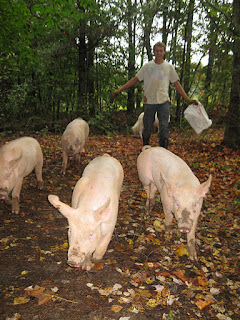Hello all, In the coming week we will be attending the final holiday farmers markets of the season in Hickory and Conover. We are taking orders for our pastured chickens and forest raised pork for pick up at market. Remember we can only produce chickens seasonally, we are butchering our last birds before April of next year.
The Holiday market dates are:
Catawba Valley Brewery Farmer Friday 11/18 5pm-7pm
Conover Holiday Market Saturday 11/19 10am -2pm
Hickory Holiday Market Wednesday 11/23 Noon-5:30
Making your Order
1
At the bottom of this blog is an order form for our holiday market selection. Use the order form as a menu. Choose chickens and pork cuts from the list and copy and paste your choices into an email. Don't forget to include the quantity of each item you wish to have.
2
Select which location you would like to pick up your order at:
Catawba Valley Brewery Farmer Friday 11/18 5pm-7pm
Conover Holiday Market Saturday 11/19 10am -2pm
Hickory Holiday Market Wednesday 11/23 Noon-5:30
Special notes:
We will also have our fall vegetables available at markets. We raise our vegetables following all organic rules: no synthetic fertilizers, pesticides, herbicides, or fungicides. We will have crunchy head lettuce, and other great fall crops available.
We will not be taking preorders for eggs because of limited supply (they don't lay as much in the short days) and high demand.
We look forward to seeing you at the holiday markets!
***********************************************************************************
Order Form
**********************************************************************************
The end of the Farmers market Season is just around the corner. Order your pastured pork and chicken for pick up in November at the final Holiday Markets of the season. Stock up on Bluebird Farm pastured chicken.
The birds will keep all winter in your freezer, but they won’t need to because there’s nothing better than a warm fresh roasted chicken on a chilly winter’s day.
Delivery Locations Date Time
Catawba Valley Brewery Farmer Friday 11/18 5pm-7pm
Conover Holiday Market Saturday 11/19 10am -2pm
Hickory Holiday Market Wednesday 11/23 Noon-5:30
Pastured Chicken Quantity
3.75-4.25 lbs 4.00/lb
4.25-4.75 lbs 4.00/lb
Pastured Pork Quantity/Number of Packs
Pork Chops, bone in 2/package 7.50/lb
Bratwurst Limited supply: about 1 lb 5.66/lb
Italian Sausage, links About 1 lb 5.66/lb
Italian sausage, ground 1 lb 5.66/lb
Country Sausage, mild 1 lb 4.90/lb
Country Sausage, hot 1 lb 4.90/lb
Chorizo 1 lb 4.90/lb
Fresh Ground Pork 1 lb 4.75/lb
Fresh Ham Roast Limited supply: 2.5-3.3 lbs 4.60/lb
Shoulder Roast Sold out until Dec. 4.60/lb
Spare Ribs 4.50/lb
Country Backbones 2.00/lb
Uncured Bacon (sliced side meat)
About 1.1 lbs per pack 6.50/lb
Whole Belly Great for smoking: 1-2.5 lbs 6.50/lb
Fat Back, unsalted 1.50/lb
Leaf Lard, unrendered The best biscuits ever! 1.50/lb
Artisan Salami Aged for 2 months
Sweet Soppressata Red wine, garlic, and herb 7.99/ea
Pepperoni Excellant peppery flavor 7.99/ea
We will continue to have special orders available for delivery to Conover and Hickory monthly or twice a month from December through March.










































